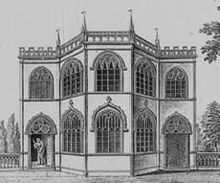Thomas Hudson
Thomas Hudson (* 1701 in Devon ; † January 26, 1779 in Twickenham near London ) was a British portrait painter and art collector . He was considered a "portraitist of the British establishment".
Life
Hudson studied painting with the portrait painter Jonathan Richardson in London, who also drew a portrait of Hudson. Shortly before 1725, he also married his daughter, albeit against his own will. After her death, he married a second wife Mrs. Fiennes.
Hudsons became known in the 1730s, his most labor-intensive time was in the twenty years between 1740 and 1760. Between 1745 and 1755 he was even considered the most successful portrait painter in London, he was the "fashion portraitist" and developed portraiture into a specifically English art form. From 1753 he lived in Cross Deep in Twickenham, today a district of Greater London, in his Gothic house, which he had built on the property acquired from the estate of the architect Roger Morris , who died in 1749 .
In his London studio, Hudson employed several people to help him with his pictures. He painted at least 400 portraits, about 80 of which were distributed as copper engravings . He was the portraitist of the royal family around George II , the court nobility , the gentry , church princes, scholars, actors and musicians. The two only surviving portraits of George Frideric Handel's age come from him from 1749 and 1756. Both artists had known each other for a long time. Hudson is said to have painted around 15 portraits of Handel.
Hudson belonged to a group of artists with William Hogarth , who influenced him strongly, Allan Ramsay , Francis Hayman (1708–1776) and the sculptor John Michael Rysbrack (1694–1770). His students also included Joshua Reynolds , who came in 1740 at the age of 17 and stayed with him until 1743, Joseph Wright of Derby, and Thomas Jenkins . However, around 1755, when his student Reynolds and Allan Ramsay became more popular, his own style of painting portraits went completely out of fashion. Therefore he gave up painting in 1767. His extensive private collection was sold at auctions in London at Langford (1779) and Christie's (1785) after his death .
Today, many of his works can be found in galleries and museums such as the National Portrait Gallery in London, the National Maritime Museum in Greenwich and the Tate Gallery .
literature
- Ellen Gross Miles: Thomas Hudson (1701-1779). Portraitist to the British Establishment , Dissertation, Yale University, 1976
- Ellen Gross Miles, Jacob Simon: Thomas Hudson (1701-1779). Portrait Painter and Collector , Catalog of an exhibition at the Iveagh Bequest, Greater London Council, Kenwood House, London 1979
Web links
- Thomas Hudson online (Artcyclopedia)
- Examples of works on artnet.de
- biography
- biography
- History of Artist Thomas Hudson
Individual evidence
- ^ Ellen G. Miles: Thomas Hudson, Portraitist to the British Establishment , 1976
- ^ Charles Knight : English Cyclopedia , 1854 ( online )
- ^ Alfred Leroy: History of the English Painting , Verlag Scientia AG, 1944
- ↑ Kurt Taut: Händel-Jahrbuch , Georg-Friedrich-Händel-Gesellschaft, Deutscher Verlag für Musik, 2003, ISBN 3761814437 or ISBN 9783761814437 , page 196ff.
- ↑ The Handel portrait from 1749 was discovered and acquired by the Hamburg Handel researcher Friedrich Chrysander from Handel's descendants in Calbe an der Saale in 1869 . He left the painting to the Hamburg merchant Friedrich Validzow on the condition that he would transfer it to the Hamburg City Library after his death , which happened in 1883.
- ↑ biography
| personal data | |
|---|---|
| SURNAME | Hudson, Thomas |
| BRIEF DESCRIPTION | British portrait painter |
| DATE OF BIRTH | 1701 |
| PLACE OF BIRTH | Devon |
| DATE OF DEATH | January 26, 1779 |
| Place of death | Twickenham , London |

